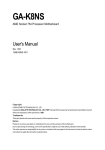Download GIGABYTE GA-K8VT800 User's Manual
Transcript
GA-K8VT800 AMD Socket 754 Processor Motherboard User's Manual Rev. 2002 12ME-K8VT800-2002 Motherboard GA-K8VT800 Jan. 10, 2005 Motherboard GA-K8VT800 Jan. 10, 2005 Copyright © 2005 GIGA-BYTE TECHNOLOGY CO., LTD. All rights reserved. The trademarks mentioned in the manual are legally registered to their respective companies. Notice The written content provided with this product is the property of Gigabyte. No part of this manual may be reproduced, copied, translated, or transmitted in any form or by any means without Gigabyte's prior written permission. Specifications and features are subject to change without prior notice. Product Manual Classification In order to assist in the use of this product, Gigabyte has categorized the user manual in the following: For quick installation, please refer to the "Hardware Installation Guide" included with the product. For detailed product information and specifications, please carefully read the "Product User Manual". For detailed information related to Gigabyte's unique features, please go to the "Technology Guide" section on Gigabyte's website to read or download the information you need. For more product details, please click onto Gigabyte's website at www.gigabyte.com.tw Table of Contents GA-K8VT800 Motherboard Layout ................................................................................ 6 Block Diagram ................................................................................................................ 7 Chapter 1 Hardware Installation .................................................................................... 9 1-1 1-2 1-3 Considerations Prior to Installation .................................................................... 9 Feature Summary .......................................................................................... 10 Installation of the CPU and Heatsink .............................................................. 12 1-3-1 1-3-2 1-4 1-5 1-6 1-7 Installation of the CPU ......................................................................................... 12 Installation of the Heatsink .................................................................................. 13 Installation of Memory .................................................................................... 13 Installation of Expansion Cards ...................................................................... 15 I/O Back Panel Introduction ........................................................................... 16 Connectors Introduction .................................................................................. 17 Chapter 2 BIOS Setup ................................................................................................ 29 The Main Menu (For example: BIOS Ver. : E8) ....................................................... 30 2-1 Standard CMOS Features ............................................................................. 32 2-2 Advanced BIOS Features .............................................................................. 34 2-3 Integrated Peripherals ..................................................................................... 35 2-4 2-5 2-6 2-7 Power Management Setup ............................................................................. 38 PnP/PCI Configurations ................................................................................. 40 PC Health Status ........................................................................................... 41 Frequency/Voltage Control ............................................................................. 42 2-8 2-9 2-10 2-11 Top Performance ............................................................................................. 43 Load Fail-Safe Defaults ................................................................................... 43 Load Optimized Defaults ................................................................................. 44 Set Supervisor/User Password ..................................................................... 44 2-12 2-13 Save & Exit Setup ......................................................................................... 45 Exit Without Saving ....................................................................................... 45 -4- Chapter 3 Drivers Installation ...................................................................................... 47 3-1 3-2 Install Chipset Drivers .................................................................................... 47 Software Application ....................................................................................... 48 3-3 3-4 3-5 Software Information ....................................................................................... 48 Hardware Information ..................................................................................... 49 Contact Us ..................................................................................................... 49 Chapter 4 Appendix ................................................................................................... 51 4-1 Unique Software Utilities ................................................................................ 51 4-1-1 4-1-2 4-1-3 4-1-4 4-2 Xpress Recovery Introduction ........................................................................... 51 Flash BIOS Method Introduction ........................................................................ 54 Serial ATA BIOS Setting Utility Introduction ...................................................... 63 2- / 4- / 6- / 8- Channel Audio Function Introduction ...................................... 69 Troubleshooting ............................................................................................... 77 -5- KB_MS DDR3 DDR2 DDR1 GA-K8VT800 Motherboard Layout COMA CPU_FAN ATX_12V ATX LAN USB USB COMB LPT Socket 754 AUDIO VIA K8T800 F_AUDIO FDD RTL 8100C AGP BATTERY CODEC PCI1 IDE1 CD_IN PCI3 PCI4 BIOS SPDIF_IO IR IDE2 GA-K8VT800 IT8705F PCI2 F_USB1 F_USB2 -6- SYS_FAN CLR_CMOS PWR_LED F_PANEL PCI5 SUR_CEN SATA1 SATA0 VIA VT8237R Block Diagram AGP slot 4X/8X AMD Athlon TM 64 processor (K8) AGPCLK (66MHz) CPUCLK+/- (200MHz) System Bus 800MHz DDR400/333/266/200 DIMM DDR RAM VIA K8T800 AGPCLK66MHz 5 PCI RJ45 RTL8100C 66MHz V_Link LAN 48 MHz VIA VT8237R PS/2 KB/Mouse AC97 Link Floppy IT8705F LPT Port BIOS 2 SATA 8 USB ATA66/100/133 24 MHz Ports Ports IDE Channels 33 MHz COM Ports MIC LINE-IN LINE-OUT PCICLK (33MHz) AC97 CODEC 33 MHz 14.318 MHz -7- -8- 1-1 English Chapter 1 Hardware Installation Considerations Prior to Installation Preparing Your Computer The motherboard contains numerous delicate electronic circuits and components which can become damaged as a result of electrostatic discharge (ESD). Thus, prior to installation, please follow the instructions below: 1. Please turn off the computer and unplug its power cord. 2. When handling the motherboard, avoid touching any metal leads or connectors. 3. It is best to wear an electrostatic discharge (ESD) cuff when handling electronic components (CPU, RAM). 4. Prior to installing the electronic components, please have these items on top of an antistatic pad or within a electrostatic shielding container. 5. Please verify that you the power supply is switched off before unplugging the power supply connector from the motherboard. Installation Notices 1. Prior to installation, please do not remove the stickers on the motherboard. These stickers are required for warranty validation. 2. Prior to the installation of the motherboard or any hardware, please first carefully read the information in the provided manual. 3. Before using the product, please verify that all cables and power connectors are connected. 4. To prevent damage to the motherboard, please do not allow screws to come in contact with the motherboard circuit or its components. 5. Please make sure there are no leftover screws or metal components placed on the motherboard or within the computer casing. 6. Please do not place the computer system on an uneven surface. 7. Turning on the computer power during the installation process can lead to damage to system components as well as physical harm to the user. 8. If you are uncertain about any installation steps or have a problem related to the use of the product, please consult a certified computer technician. Instances of Non-Warranty 1. 2. 3. 4. 5. 6. Damage due to natural disaster, accident or human cause. Damage as a result of violating the conditions recommended in the user manual. Damage due to improper installation. Damage due to use of uncertified components. Damage due to use exceeding the permitted parameters. Product determined to be an unofficial Gigabyte product. -9- Hardware Installation English 1-2 Feature Summary CPU Chipset Memory Slots IDE Connections FDD Connections Onboard SATA Peripherals Onboard LAN Onboard Audio I/O Control Hardware Monitor Socket 754 for AMD AthlonTM 64 processor (K8) 1600MT/s system bus Northbridge: VIA K8T800 Southbridge: VIA VT8237R 3 DDR DIMM memory slots (supports up to 3GB) Supports DDR 400/333/266/200 DIMMs 1 AGP slot supports 8X/4X(1.5V) mode 5 PCI slots 2 IDE connection (UDMA 133/100/66/33), allows connection of 4 IDE devices 1 FDD connection, allows connection of 2 FDD devices 2 Serial ATA ports from VIA VT8237R (SATA0, SATA1)(Note 1) 1 parallel port supporting Normal/EPP/ECP mode 2 serial ports (COMA, COMB) 8 USB 2.0/1.1 ports (rear x 4, front x 4 via cable) 1 front audio connector 1 IR connector 1 PS/2 keyboard port 1 PS/2 mouse port Onboard RTL8100C chip (10/100 Mbit/s) 1 RJ45 port ALC850 CODEC (UAJ) Supports Jack Sensing function Supports 2 / 4 / 6 / 8 channel audio(Note2) Supports Line In ; Line Out ;MIC Surround Back Speaker (by optional Audio Combo Kit) SPDIF In/Out connection CD In connection IT8705F System voltage detection CPU temperature detection CPU / System fan speed detection CPU / System fan failure warning (Note 1) It is recommended to use SATA (1.5Gb/s) hard disks. (Note 2) To set up an 8 channel audio configuration, you must use Audio Combo Kit (optional device). GA-K8VT800 Motherboard - 10 - Onboard VT8237R chipset (SATA0, SATA1) supports data striping (RAID 0) or mirroring (RAID 1) function supports JBOD function supports data transfer rate of up to 150 MB/s supports a maximum of 2 SATA connections Use of licensed AWARD BIOS Supports Q-Flash Supports @BIOS Supports EasyTune Over Voltage via BIOS (CPU/ DDR/ AGP) Over Clock via BIOS (CPU) ATX form factor; 29.5cm x 21.5cm - 11 - Hardware Installation English Onboard SATA RAID BIOS Additional Features Overclocking Form Factor English 1-3 Installation of the CPU and Heatsink Before installing the CPU, please comply with the following conditions: 1. Please make sure that the motherboard supports the CPU. 2. Please take note of the one indented corner of the CPU. If you install the CPU in the wrong direction, the CPU will not insert properly. If this occurs, please change the insert direction of the CPU. 3. Please add an even layer of heat sink paste between the CPU and heatsink. 4. Please make sure the heatsink is installed on the CPU prior to system use, otherwise overheating and permanent damage of the CPU may occur. 5. Please set the CPU host frequency in accordance with the processor specifications. It is not recommended that the system bus frequency be set beyond hardware specifications since it does not meet the required standards for the peripherals. If you wish to set the frequency beyond the proper specifications, please do so according to your hardware specifications including the CPU, graphics card, memory, hard drive, etc. 1-3-1 Installation of the CPU Check the processor pins to see that none are bent. Move the socket lever to the unlocked position as shown in Figure 1.(90 o to the plane of the motherboard) prior to inserting the processor. The pin 1 location is designated on the processor by a copper triangle that matches up to a triangle on the socket as shown in Figure 2. Align the processor to the socket and gently lower it into place. Do not force the processor into the socket. Socket lever Fig.1 Position lever at a 90 degree angle. Fig.2 Pin 1 location on the Socket and Processor. Move the socket lever to the locked position while holding pressure on the center of the processor. Please be careful when installing the CPU. The CPU will not fit if positioned incorrectly. Rather than applying force, please change the positioning of the CPU. GA-K8VT800 Motherboard - 12 - Fig.1 Before installing the heat sink, please first add an even layer of heat sink paste on the surface of the CPU. Install all the heat sink components (Please refer to the heat sink manual for detailed installation instructions). Fig.2 Please connect the heat sink power connector to the CPU_FAN connector located on the motherboard so that the heat sink can properly function to prevent CPU overheating. The heat sink may adhere to the CPU as a result of hardening of the heat sink paste. To prevent such an occurrence, it is suggested that either thermal tape rather than heat sink paste be used for heat dissipation or using extreme care when removing the heat sink. 1-4 Installation of Memory Before installing the memory modules, please comply with the following conditions: 1. Please make sure that the memory used is supported by the motherboard. It is recommended that memory of similar capacity, specifications and brand be used. 2. Before installing or removing memory modules, please make sure that the computer power is switched off to prevent hardware damage. 3. Memory modules have a foolproof insertion design. A memory module can be installed in only one direction. If you are unable to insert the module, please switch the direction. The motherboard supports DDR memory modules, whereby BIOS will automatically detect memory capacity and specifications. Memory modules are designed so that they can be inserted only in one direction. The memory capacity used can differ with each slot. Notch DDR - 13 - Hardware Installation English 1-3-2 Installation of the Heatsink English Fig.1 The DIMM socket has a notch, so the DIMM memory module can only fit in one direction. Insert the DIMM memory module vertically into the DIMM socket. Then push it down. Fig.2 Close the plastic clip at both edges of the DIMM sockets to lock the DIMM module. Reverse the installation steps when you wish to remove the DIMM module. Please refer to the recommended memory configuration table below before installing memory. Recommended Memory Configurations (SS: Single -Sided, DS:Double-Sided) Number of DIMMs DIMM Socket Max. Memory Speed DDR1 DDR2 DDR3 1 SS -- -SS --- DDR 400 DDR 400 1 -- -- SS DDR 400 1 1 DS -- -- DDR 400 1 --- DS -- -DS DDR 400 DDR 400 2 SS SS -- DDR 400 2 2 -- SS SS DDR 400 2 SS DS -DS SS -- DDR 400 DDR 400 2 -- DS DS DDR 333 2 3 DS -- DS DDR 400 SS DS SS DS SS DS DDR 400 DDR 333 1 3 GA-K8VT800 Motherboard - 14 - Installation of Expansion Cards You can install your expansion card by following the steps outlined below: 1. Read the related expansion card's instruction document before install the expansion card into the computer. 2. Remove your computer's chassis cover, screws and slot bracket from the computer. 3. Press the expansion card firmly into expansion slot in motherboard. 4. Be sure the metal contacts on the card are indeed seated in the slot. 5. Replace the screw to secure the slot bracket of the expansion card. 6. Replace your computer's chassis cover. 7. Power on the computer, if necessary, setup BIOS utility of expansion card from BIOS. 8. Install related driver from the operating system. Installing an AGP VGA card: Please carefully pull out the small whitedrawable bar at the end of the AGP slot when you try to install/uninstall the VGA card. Please align the VGA card to the onboard AGP slot and press firmly down on the slot. Make sure your VGA card is locked by the small white-drawable bar. - 15 - Hardware Installation English 1-5 English 1-6 I/O Back Panel Introduction PS/2 Keyboard and PS/2 Mouse Connector To install a PS/2 port keyboard and mouse, plug the mouse to the upper port (green) and the keyboard to the lower port (purple). Parallel Port The parallel port allows connection of a printer, scanner and other peripheral devices. COMA, COMB (Serial Port) Connects to serial-based mouse or data processing devices. USB port Before you connect your device(s) into USB connector(s), please make sure your device(s) such as USB keyboard, mouse, scanner, zip, speaker...etc. have a standard USB interface. Also make sure your OS supports USB controller. If your OS does not support USB controller, please contact OS vendor for possible patch or driver upgrade. For more information please contact your OS or device(s) vendors. LAN Port The provided Internet connection providing data transfer speeds of 10/100Mbps. Line In Devices like CD-ROM, walkman etc. can be connected to Line In jack. Line Out Connect the stereo speakers, earphone or front surround speakers to this connector. MIC In Microphone can be connected to MIC In jack. You can use audio software to configure 2-/4-/6-/8-channel audio function. GA-K8VT800 Motherboard - 16 - Connectors Introduction 1 English 1-7 3 2 5 10 17 11 6 7 4 16 12 13 1) 2) 3) 4) 5) 6) 7) 8) 9) ATX_12V ATX (Power Connector) CPU_FAN SYS_FAN FDD IDE1 / IDE2 SATA0 / SATA1 PWR_LED F_PANEL 15 14 10) 11) 12) 13) 14) 15) 16) 17) - 17 - 8 9 F_AUDIO CD_IN SPDIF_IO SUR_CEN F_USB1 / F_USB2 IR CLR_CMOS BATTERY Hardware Installation English 1/2) ATX_12V / ATX (Power Connector) With the use of the power connector, the power supply can supply enough stable power to all the components on the motherboard. Before connecting the power connector, please make sure that all components and devices are properly installed. Align the power connector with its proper location on the motherboard and connect tightly. The ATX_12V power connector mainly supplies power to the CPU. If the ATX_12V power connector is not connected, the system will not start. Caution! Please use a power supply that is able to handle the system voltage requirements. It is recommended that a power supply that can withstand high power consumption be used (300W or greater). If a power supply is used that does not provide the required power, the result can lead to an unstable system or a system that is unable to start. 4 3 Pin No. 1 2 1 2 GND 3 +12V 4 +12V Pin No. 11 20 GA-K8VT800 Motherboard - 18 - 1 10 Definition GND Definition 1 2 3.3V 3.3V 3 GND 4 5 +5V GND 6 +5V 7 GND 8 9 Power Good 5V SB (stand by +5V) 10 +12V 11 3.3V 12 13 -12V GND 14 PS_ON(soft on/off) 15 GND 16 17 GND GND 18 -5V 19 +5V 20 +5V The cooler fan power connector supplies a +12V power voltage via a 3-pin power connector and possesses a foolproof connection design. Most coolers are designed with color-coded power connector wires. A red power connector wire indicates a positive connection and requires a +12V power voltage. The black connector wire is the ground wire (GND). Please remember to connect the power to the cooler to prevent system overheating and failure. Caution! Please remember to connect the power to the CPU fan to prevent CPU overheating and failure. Pin No. 1 - 19 - 1 Definition GND 2 +12V 3 Sense Hardware Installation English 3/4) CPU_FAN / SYS_FAN (Cooler Fan Power Connector) English 5) FDD (FDD Connector) The FDD connector is used to connect the FDD cable while the other end of the cable connects to the FDD drive. The types of FDD drives supported are: 360KB, 720KB, 1.2MB, 1.44MB and 2.88MB. Please connect the red power connector wire to the pin1 position. 34 33 2 1 6) IDE1 / IDE2 (IDE Connector) An IDE device connects to the computer via an IDE connector. One IDE connector can connect to one IDE cable, and the single IDE cable can then connect to two IDE devices (hard drive or optical drive). If you wish to connect two IDE devices, please set the jumper on one IDE device as Master and the other as Slave (for information on settings, please refer to the instructions located on the IDE device). 39 1 IDE1 IDE2 40 GA-K8VT800 Motherboard - 20 - 2 Serial ATA can provide up to 150MB/s transfer rate. Please refer to the BIOS setting for the Serial ATA and install the proper driver in order to work properly. Pin No. 1 7 Definition 1 GND 2 TXP 3 4 TXN GND 5 RXN 6 RXP 7 GND 8) PWR_LED PWR_LED is connect with the system power indicator to indicate whether the system is on/off. It will blink when the system enters suspend mode. Pin No. 1 - 21 - Definition 1 2 MPD+ MPD- 3 MPD- Hardware Installation English 7) SATA0/ SATA1 (Serial ATA Connector) English 9) F_PANEL (Front Panel Jumper) Please connect the power LED, PC speaker, reset switch and power switch etc of your chassis front panel to the F_PANEL connector according to the pin assignment below. Soft Power Connector Message LED/Power/ Sleep LED PWPW+ MSGMSG+ 2 HD+ HD- RST- NC RST+ Reset Switch HD (IDE Hard Disk Active LED) (Blue) Pin 1: LED anode(+) Pin 2: LED cathode(-) SPEAK (Speaker Connector) Pin 1: Power (Amber) Pin 2- Pin 3: NC RES (Reset Switch) Pin 4: Data(-) Open: Normal (Green) Close: Reset Hardware System PW (Power Switch) Open: Normal (Red) MSG(Message LED/Power/Sleep LED) Close: Power On/Off Pin 1: LED anode(+) (Yellow) Pin 2: LED cathode(-) NC (Purple) NC GA-K8VT800 Motherboard - 22 - SPK+ SPK20 19 1 IDE Hard Disk Active LED Speaker Connector If you want to use Front Audio connector, you must remove 5-6, 9-10 Jumper. In order to utilize the front audio header, your chassis must have front audio connector. Also please make sure the pin assigment on the cable is the same as the pin assigment on the MB header. To find out if the chassis you are buying support front audio connector, please contact your dealer. Please note, you can have the alternative of using front audio connector or of using rear audio connector to play sound. Pin No. 10 9 2 1 Definition 1 MIC 2 3 GND MIC_BIAS 4 POWER 5 FrontAudio(R) 6 7 Rear Audio (R)/ Return R NC 8 9 10 No Pin FrontAudio (L) Rear Audio (L)/ Return L 11) CD_IN (CD In Connector) Connect CD-ROM or DVD-ROM audio out to the connector. 1 - 23 - Pin No. 1 Definition CD-L 2 GND 3 GND 4 CD-R Hardware Installation English 10) F_AUDIO (Front Audio Panel Connector) English 12) SPDIF_IO (SPDIF In / Out Connector) The SPDIF output is capable of providing digital audio to external speakers or compressed AC3 data to an external Dolby Digital Decoder. Use this feature only when your stereo system has digital input and output function. Use SPDIF in feature only when your device has digital output function. Be careful with the polarity of the SPDIF_IO connector. Check the pin assignment carefully while you connect the SPDIF cable, incorrect connection between the cable and connector will make the device unable to work or even damage it. For optional SPDIF cable, please contact your local dealer. 2 6 1 5 Pin No. 1 Definition Power 2 No Pin 3 SPDIF 4 5 SPDIFI GND 6 GND 13) SUR_CEN (Surround Center Connector) Please contact your nearest dealer for optional SUR_CEN cable. 2 1 GA-K8VT800 Motherboard - 24 - 8 7 Pin No. 1 Definition SUR OUTL 2 SUR OUTR 3 GND 4 5 No Pin CENTER_OUT 6 BASS_OUT 7 AUX_L 8 AUX_R Be careful with the polarity of the front USB connector. Check the pin assignment carefully while you connect the front USB cable, incorrect connection between the cable and connector will make the device unable to work or even damage it. For optional front USB cable, please contact your local dealer. Pin No. 1 2 1 Definition Power 10 2 9 3 Power USB DX- 4 5 USB DyUSB DX+ 6 USB Dy+ 7 GND 8 9 GND No Pin 10 NC 15) IR Check the pin assignments carefully while you connect the IR cable because incorrect connection between the cable and connector will make the device unable to work or even damage it. For optional IR cable, please contact your local dealer. Pin No. 1 - 25 - Definition 1 Power 2 No Pin 3 4 IR RX GND 5 IR TX Hardware Installation English 14) F_ USB1 / F_USB2 (Front USB Connector) English 16) CLR_CMOS (Clear CMOS) You may clear the CMOS data to its default values by this jumper. To clear CMOS, temporarily short 1-2 pin. Default doesn't include the "Shunter" to prevent from improper use this jumper. 1 Open: Normal Short: Clear CMOS 1 17) BATTERY Danger of explosion if battery is incorrectly replaced. Replace only with the same or equivalent type recommended by the manufacturer. Dispose of used batteries according to the manufacturer's instructions. If you want to erase CMOS... 1. Turn OFF the computer and unplug the power cord. 2. Take out the battery gently and put it aside for about 10 minutes. (Or you can use a metal object to connect the positive and negative pins in the battery holder to makethem short for one minute.) 3. Re-install the battery. 4. Plug the power cord and turn ON the computer. GA-K8VT800 Motherboard - 26 - English - 27 - Hardware Installation English GA-K8VT800 Motherboard - 28 - BIOS (Basic Input and Output System) includes a CMOS SETUP utility which allows user to configure required settings or to activate certain system features. The CMOS SETUP saves the configuration in the CMOS SRAM of the motherboard. When the power is turned off, the battery on the motherboard supplies the necessary power to the CMOS SRAM. When the power is turned on, pushing the <Del> button during the BIOS POST (Power-On Self Test) will take you to the CMOS SETUP screen. You can enter the BIOS setup screen by pressing "Ctrl + F1". When setting up BIOS for the first time, it is recommended that you save the current BIOS to a disk in the event that BIOS needs to be reset to its original settings. If you wish to upgrade to a new BIOS, either GIGABYTE's Q-Flash or @BIOS utility can be used. Q-Flash allows the user to quickly and easily update or backup BIOS without entering the operating system. @BIOS is a Windows-based utility that does not require users to boot to DOS before upgrading BIOS but directly download and update BIOS from the Internet. CONTROL KEYS < >< >< <Enter> <Esc> <Page Up> <Page Down> <F1> <F2> <F5> <F6> <F7> <F8> <F9> <F10> >< > Move to select item Select Item Main Menu - Quit and not save changes into CMOS Status Page Setup Menu and Option Page Setup Menu - Exit current page and return to Main Menu Increase the numeric value or make changes Decrease the numeric value or make changes General help, only for Status Page Setup Menu and Option Page Setup Menu Item Help Restore the previous CMOS value from CMOS, only for Option Page Setup Menu Load the Fail-Safe Defaults CMOS value from BIOS default table Load the Optimized Defaults Q-Flash utility System Information Save all the CMOS changes, only for Main Menu Main Menu The on-line description of the highlighted setup function is displayed at the bottom of the screen. Status Page Setup Menu / Option Page Setup Menu Press <F1> to pop up a small help window that describes the appropriate keys to use and the possible selections for the highlighted item. To exit the Help Window press <Esc>. - 29 - BIOS Setup English Chapter 2 BIOS Setup English The BIOS Setup menus described in this chapter are for reference only and may differ from the exact settings for your motherboard. The Main Menu (For example: BIOS Ver. : E8) Once you enter Award BIOS CMOS Setup Utility, the Main Menu (as figure below) will appear on the screen. Use arrow keys to select among the items and press <Enter> to accept or enter the sub-menu. CMOS Setup Utility-Copyright (C) 1984-2004 Award Software ` ` Standard CMOS Features Advanced BIOS Features Top Performance Load Fail-Safe Defaults ` ` Integrated Peripherals Power Management Setup Load Optimized Defaults Set Supervisor Password ` ` PnP/PCI Configurations PC Health Status Set User Password Save & Exit Setup ` Frequency/Voltage Control Exit Without Saving KLJI: Select Item F10: Save & Exit Setup Esc: Quit F8: Q-Flash Time, Date, Hard Disk Type... If you can't find the setting you want, please press "Ctrl+F1" to search the advanced option hidden. Standard CMOS Features This setup page includes all the items in standard compatible BIOS. Advanced BIOS Features This setup page includes all the items of Award special enhanced features. Integrated Peripherals This setup page includes all onboard peripherals. Power Management Setup This setup page includes all the items of Green function features. PnP/PCI Configuration This setup page includes all the configurations of PCI & PnP ISA resources. PC Health Status This setup page is the System auto detect Temperature, voltage, fan, speed. Frequency/Voltage Control This setup page is control CPU clock and frequency ratio. Top Performance If you wish to maximize the performance of your system, enable Top Performance. Load Fail-Safe Defaults Fail-Safe Defaults indicates the value of the system parameters which the system would be in safe configuration. GA-K8VT800 Motherboard - 30 - Optimized Defaults indicates the value of the system parameters which the system would be in best performance configuration. Set Supervisor Password Change, set, or disable password. It allows you to limit access to the system and Setup, or just to Setup. Set User Password Change, set, or disable password. It allows you to limit access to the system. Save & Exit Setup Save CMOS value settings to CMOS and exit setup. Exit Without Saving Abandon all CMOS value changes and exit setup. - 31 - BIOS Setup English Load Optimized Defaults English 2-1 Standard CMOS Features CMOS Setup Utility-Copyright (C) 1984-2004 Award Software Standard CMOS Features ` ` ` ` ` ` Date (mm:dd:yy) Time (hh:mm:ss) Thu, Jun 17 2004 22:31:24 Item Help Menu Level` IDE Channel 0 Master IDE Channel 0 Slave IDE Channel 1 Master IDE Channel 1 Slave IDE Channel 2 Master IDE Channel 3 Master [None] [None] [None] [None] [None] [None] Change the day, month, year Drive A Drive B Floppy 3 Mode Support [1.44M, 3.5"] [None] [Disabled] Halt On [All, But Keyboard] Base Memory Extended Memory Total Memory 640K 511M 512M KLJI: Move Enter: Select F5: Previous Values +/-/PU/PD: Value F6: Fail-Safe Defaults <Week> Sun. to Sat. <Month> Jan. to Dec. <Day> 1 to 31 (or maximum allowed in the month) <Year> 1999 to 2098 F10: Save ESC: Exit F7: Optimized Defaults F1: General Help Date The date format is <week>, <month>, <day>, <year>. Week The week, from Sun to Sat, determined by the BIOS and is display only Month The month, Jan. Through Dec. Day The day, from 1 to 31 (or the maximum allowed in the month) Year The year, from 1999 through 2098 Time The times format in <hour> <minute> <second>. The time is calculated base on the 24-hour militarytime clock. For example, 1 p.m. is 13:00:00. IDE Channel 0 Master/Slave; IDE Channel 1 Master/Slave IDE HDD Auto-Detection Press "Enter" to select this option for automatic device detection. IDE Channel 0 Master/Slave; IDE Channel 1 Master/Slave setup. You can use one of three methods: Auto Allows BIOS to automatically detect IDE devices during POST. (Default value) None Select this if no IDE devices are used and the system will skip the automatic detection step and allow for faster system start up. Manual User can manually input the correct settings. Access Mode Use this to set the access mode for the hard drive. The four options are: CHS/LBA/Large/Auto(default:Auto) IDE Channel 2/3 Master IDE HDD Auto-Detection Press "Enter" to select this option for automatic device detection. Extended IDE Drive setup You can use one of two methods: Auto Allows BIOS to automatically detect IDE devices during POST. (Default value) None Select this if no IDE devices are used and the system will skip the automatic detection step and allow for faster system start up. Access Mode Use this to set the access mode for the hard drive. The two options are: Large/Auto(default:Auto) GA-K8VT800 Motherboard - 32 - Drive A/Drive B The category identifies the types of floppy disk drive A or drive B that has been installed in the computer. None No floppy drive installed 360K, 5.25" 5.25 inch PC-type standard drive; 360K byte capacity. 1.2M, 5.25" 5.25 inch AT-type high-density drive; 1.2M byte capacity (3.5 inch when 3 Mode is Enabled). 720K, 3.5" 3.5 inch double-sided drive; 720K byte capacity 1.44M, 3.5" 3.5 inch double-sided drive; 1.44M byte capacity. 2.88M, 3.5" 3.5 inch double-sided drive; 2.88M byte capacity. Floppy 3 Mode Support (for Japan Area) Disabled Drive A Drive B Both Halt on Normal Floppy Drive. (Default value) Drive A is 3 mode Floppy Drive. Drive B is 3 mode Floppy Drive. Drive A & B are 3 mode Floppy Drives. The category determines whether the computer will stop if an error is detected during power up. No Errors The system boot will not stop for any error that may be detected and you will be prompted. All Errors Whenever the BIOS detects a non-fatal error the system will be stopped. All, But Keyboard The system boot will not stop for a keyboard error; it will stop for all other errors. (Default value) All, But Diskette The system boot will not stop for a disk error; it will stop for all other errors. All, But Disk/Key The system boot will not stop for a keyboard or disk error; it will stop for all other errors. Memory The category is display-only which is determined by POST (Power On Self Test) of the BIOS. Base Memory The POST of the BIOS will determine the amount of base (or conventional) memory installed in the system. The value of the base memory is typically 512K for systems with 512K memory installed on the motherboard, or 640K for systems with 640K or more memory installed on the motherboard. Extended Memory The BIOS determines how much extended memory is present during the POST. This is the amount of memory located above 1 MB in the CPU's memory address map. Total Memory This item displays the memory size that used. - 33 - BIOS Setup English Capacity Capacity of currently installed hard disk. Hard drive information should be labeled on the outside drive casing. Enter the appropriate option based on this information. Cylinder Number of cylinders Head Number of heads Precomp Write precomp Landing Zone Landing zone Sector Number of sectors If a hard disk has not been installed, select NONE and press <Enter>. English 2-2 Advanced BIOS Features CMOS Setup Utility-Copyright (C) 1984-2004 Award Software Advanced BIOS Features ` Hard Disk Boot Priority First Boot Device Second Boot Device Third Boot Device Password Check KLJI: Move Enter: Select F5: Previous Values [Press Enter] [Floppy] [Hard Disk] [CDROM] [Setup] +/-/PU/PD: Value F6: Fail-Safe Defaults Item Help Menu Level` Select Hard Disk Boot Device Priority F10: Save ESC: Exit F7: Optimized Defaults F1: General Help Hard Disk Boot Priority Select boot sequence for onboard(or add-on cards) SCSI, RAID, etc. Use < > or < > to select a device, then press<+> to move it up, or <-> to move it down the list. Press <ESC> to exit this menu. First / Second / Third Boot Device Floppy LS120 Hard Disk CDROM ZIP USB-FDD USB-ZIP USB-CDROM USB-HDD Legacy LAN Disabled Select your boot device priority by Floppy. Select your boot device priority by LS120. Select your boot device priority by Hard Disk. Select your boot device priority by CDROM. Select your boot device priority by ZIP. Select your boot device priority by USB-FDD. Select your boot device priority by USB-ZIP. Select your boot device priority by USB-CDROM. Select your boot device priority by USB-HDD. Select your boot device priority by LAN. Select your boot device priority by Disabled. Password Check System Setup The system can not boot and can not access to Setup page will be denied if the correct password is not entered at the prompt. The system will boot, but access to Setup will be denied if the correct password is not entered at the prompt. (Default value) GA-K8VT800 Motherboard - 34 - Integrated Peripherals English 2-3 CMOS Setup Utility-Copyright (C) 1984-2004 Award Software Integrated Peripherals IDE DMA transfer access OnChip IDE Channel 0 OnChip IDE Channel 1 OnChip Serial ATA SATA Mode AC97 Audio USB 1.1 Controller USB 2.0 Controller USB Keyboard Support USB Mouse Support Onboard H/W LAN OnBoard LAN Boot ROM Onboard FDC Controller Onboard Serial Port 1 Onboard Serial Port 2 UART Mode Select x UR2 Duplex Mode Onboard Parallel Port Parallel Port Mode Midi Port Address x Midi Port IRQ KLJI: Move Enter: Select F5: Previous Values [Enabled] [Enabled] [Enabled] [Enabled] [RAID] [Auto] [Enabled] [Enabled] [Disabled] [Disabled] [Enabled] [Disabled] [Enabled] [3F8/IRQ4] [2F8/IRQ3] [Normal] Half [378/IRQ7] [SPP] [Disabled] 10 +/-/PU/PD: Value F6: Fail-Safe Defaults Item Help Menu Level` F10: Save ESC: Exit F7: Optimized Defaults F1: General Help IDE DMA transfer access Enabled Disabled Enable IDE DMA transfer access. (Default value) Disable this function. OnChip IDE Channel0 Enabled Disabled Enable onboard 1st channel IDE port.(Default value) Disable onboard 1st channel IDE port. OnChip IDE Channel1 Enabled Disabled Enable onboard 2nd channel IDE port.(Default value) Disable onboard 2nd channel IDE port. OnChip Serial ATA Enabled Disabled Enable VT8237R Serial ATA support.(Default value) Disable this function. SATA Mode RAID IDE Set onboard SATA mode to RAID.(Default value) Set onboard SATA mode to IDE. AC97 Audio Auto Disabled Autodetect onboard AC'97 audio function. (Default value) Disable this function. USB 1.1 Controller Disabled Enabled Disable USB 1.1 controller. Enable USB 1.1 controller. (Default value) - 35 - BIOS Setup English USB 2.0 Controller Disabled Enabled Disable USB 2.0 controller. Enable USB 2.0 controller. (Default value) USB Keyboard Support Enabled Disabled Enable USB keyboard support. Disable USB keyboard support. (Default value) USB Mouse Support Enabled Disabled Enable USB mouse support. Disable USB mouse support. (Default value) Onboard H/W LAN Enabled Disabled Enable onboard LAN chip function. (Default value) Disable onboard LAN chip function. OnBoard LAN Boot ROM This function decide whether to invoke the boot ROM of the onboard LAN chip. Enabled Enable this function. Disabled Disable this function. (Default value) Onboard FDC Controller Enabled Disabled Enable onboard FDC controller. (Default value) Disable onboard FDC controller. Onboard Serial Port 1 Auto 3F8/IRQ4 2F8/IRQ3 3E8/IRQ4 2E8/IRQ3 Disabled BIOS will automatically setup the port 1 address. Enable onboard Serial port 1 and address is 3F8. (Default value) Enable onboard Serial port 1 and address is 2F8. Enable onboard Serial port 1 and address is 3E8. Enable onboard Serial port 1 and address is 2E8. Disable onboard Serial port 1. Onboard Serial Port 2 Auto 3F8/IRQ4 2F8/IRQ3 3E8/IRQ4 2E8/IRQ3 Disabled BIOS will automatically setup the port 2 address. Enable onboard Serial port 2 and address is 3F8. Enable onboard Serial port 2 and address is 2F8. (Default value) Enable onboard Serial port 2 and address is 3E8. Enable onboard Serial port 2 and address is 2E8. Disable onboard Serial port 2. UART Mode Select This item allows Normal IrDA ASKIR you to determine which Infra Red(IR) function of Onboard I/O chip. Set onboard I/O chip UART to Normal mode.(Default value) Set onboard I/O chip UART to IrDA mode. Set onboard I/O chip UART to ASKIR mode. GA-K8VT800 Motherboard - 36 - English UR2 Duplex Mode This feature allows you to select IR mode. This function is available only when UART Mode Select is not set to Normal. Half IR Function Duplex Half. (Default value) Full IR Function Duplex Full. Onboard Parallel Port Disabled 378/IRQ7 278/IRQ5 3BC/IRQ7 Disable onboard LPT port. Enable onboard LPT port and address is 378/IRQ7. (Default value) Enable onboard LPT port and address is 278/IRQ5. Enable onboard LPT port and address is 3BC/IRQ7. Parallel Port Mode SPP EPP ECP ECP+EPP Using Parallel port as Standard Parallel Port. (Default value) Using Parallel port as Enhanced Parallel Port. Using Parallel port as Extended Capabilities Port. Using Parallel port as ECP and EPP mode. Midi Port Address 300 330 Disabled Set Midi Port Address to 300. Set Midi Port Address to 330. Disable this function. (Default value) Midi Port IRQ 5 10 Set Midi Port IRQ to 5. Set Midi Port IRQ to 10. (Default value) - 37 - BIOS Setup English 2-4 Power Management Setup CMOS Setup Utility-Copyright (C) 1984-2004 Award Software Power Management Setup ACPI Suspend Type x USB Device Wake-Up From S3 Soft-Off by PWRBTN AC BACK Function Keyboard Power On Mouse Power On PME Event Wake Up Modem Ring Resume Resume by Alarm x Date (of Month) Alarm x Time (hh:mm:ss) Alarm KLJI: Move Enter: Select F5: Previous Values [S1(POS)] Disabled [Instant-Off] [Soft-Off] [Disabled] [Disabled] [Enabled] [Enabled] [Disabled] Everday 0:0:0 +/-/PU/PD: Value F6: Fail-Safe Defaults Item Help Menu Level` [S1] Set suspend type to Power On Suspend under ACPI OS [S3] Set suspend type to Suspend to RAM under ACPI OS F10: Save ESC: Exit F7: Optimized Defaults F1: General Help ACPI Suspend Type S1(POS) S3(STR) Set ACPI suspend type to S1/POS(Power On Suspend). (Default value) Set ACPI suspend type to S3/STR(Suspend To RAM). USB Device Wake-Up From S3 Disabled Enabled Disable USB Device Wake-Up from S3. (Default value) Enable USB Device Wake-Up from S3. Soft-Off by PWRBTN Instant-Off Press power button then Power off instantly. (Default value) Delay 4 Sec. Press power button 4 sec. to Power off. Enter suspend if button is pressed less than 4 sec. AC BACK Function Memory Soft-Off Full-On When AC-power back to the system, the system will be back to the last state before AC-power is lost. When AC-power back to the system, the system will be in "Off" state. (Default value) When AC-power back to the system, the system always in "On" state. Keyboard Power On Password Enter from 1 to 8 characters to set the Keyboard Power On Password. Disabled Disabled this function. (Default value) Keyboard 98 If your keyboard have "POWER Key" button, you can press the key to power on the system. Mouse Power On Disabled Enabled Disabled this function. (Default value) Double click on PS/2 mouse left button to power on the system. GA-K8VT800 Motherboard - 38 - This feature requires an ATX power supply that provides at least 1A on the 5VSB lead. Disabled Disable this function. Enabled Enable PME as wake up event. (Default value) Modem Ring Resume An incoming call via modem can awake the system from any suspend state. Disabled Disable Modem Ring Resume function. Enabled Enable Modem Ring Resume function. (Default value) Resume by Alarm You can set "Resume by Alarm" item to enabled and key in Date/Time to power on system. Disabled Disable this function. (Default value) Enabled Enable alarm function to POWER ON system. If Resume by Alarm is Enabled. Date (of Month) Alarm : Everyday, 1~31 Time (hh: mm: ss) Alarm: (0~23) : (0~59) : (0~59) - 39 - BIOS Setup English PME Event Wake Up English 2-5 PnP/PCI Configurations CMOS Setup Utility-Copyright (C) 1984-2004 Award Software PnP/PCI Configurations PCI PCI PCI PCI 1/5 IRQ Assignment 2 IRQ Assignment 3 IRQ Assignment 4 IRQ Assignment [Auto] [Auto] [Auto] [Auto] Item Help Menu Level` Device(s) using this INT: USB 1.1 Host Cntrlr -Bus 0 Dev16 Func 1 USB 1.1 Host Cntrlr -Bus 0 Dev16 Func 0 KLJI: Move Enter: Select F5: Previous Values +/-/PU/PD: Value F6: Fail-Safe Defaults F10: Save ESC: Exit F7: Optimized Defaults F1: General Help PCI 1/5 IRQ Assignment Auto 3,4,5,7,9,10,11,12,14,15 Auto assign IRQ to PCI 1/PCI 5. (Default value) Set IRQ 3,4,5,7,9,10,11,12,14,15 to PCI 1/PCI 5. PCI 2 IRQ Assignment Auto 3,4,5,7,9,10,11,12,14,15 Auto assign IRQ to PCI 2. (Default value) Set IRQ 3,4,5,7,9,10,11,12,14,15 to PCI 2. PCI 3 IRQ Assignment Auto 3,4,5,7,9,10,11,12,14,15 Auto assign IRQ to PCI 3. (Default value) Set IRQ 3,4,5,7,9,10,11,12,14,15 to PCI 3. PCI 4 IRQ Assignment Auto 3,4,5,7,9,10,11,12,14,15 GA-K8VT800 Motherboard Auto assign IRQ to PCI 4. (Default value) Set IRQ 3,4,5,7,9,10,11,12,14,15 to PCI 4. - 40 - PC Health Status CMOS Setup Utility-Copyright (C) 1984-2004 Award Software PC Health Status Vcore DDR25V +3.3V +12V Current CPU Temperature Current CPU FAN Speed Current SYSTEM FAN Speed CPU FAN Fail Warning SYSTEM FAN Fail Warning KLJI: Move Enter: Select F5: Previous Values OK OK OK OK 35 oC 3245 RPM 0 RPM [Disabled] [Disabled] +/-/PU/PD: Value F6: Fail-Safe Defaults Item Help Menu Level` [Disabled] Don't monitor current fan speed [Enabled] Alarm when FAN stops F10: Save ESC: Exit F7: Optimized Defaults F1: General Help Current Voltage(V) Vcore / DDR25V / +3.3V / +12V Detect system's voltage status automatically. Current CPU Temperature Detect CPU temperature automatically. Current CPU/SYSTEM FAN Speed (RPM) Detect CPU/SYSTEM Fan speed status automatically. CPU/SYSTEM FAN Fail Warning Disabled Enabled Disable fan fail warning function disable. (Default value) Enable fan fail warning function enable. - 41 - BIOS Setup English 2-6 English 2-7 Frequency/Voltage Control CMOS Setup Utility-Copyright (C) 1984-2004 Award Software Frequency/Voltage Control K8 CPU Clock Ratio Auto Detect DIMM/PCI Clk Spread Spectrum CPU Clock CPU OverVoltage Control AGP OverVoltage Control DIMM OverVoltage Control KLJI: Move Enter: Select F5: Previous Values [Default] [Enabled] [Enabled] [200MHz] [Auto] [Auto] [Auto] +/-/PU/PD: Value F6: Fail-Safe Defaults Item Help Menu Level` F10: Save ESC: Exit F7: Optimized Defaults F1: General Help Incorrect using these features may cause your system broken. For power end-user use only. K8 CPU Clock Ratio Default Set CPU clock ratio to default. (Default value) x4 800MHz~x10 2000MHz Set CPU clock ratio from x4 800MHz to x10 2000MHz. Auto Detect DIMM/PCI clk Enabled Disabled Detect the DIMM/PCI clock automatically. (Default value) Disable this function. Spread Spectrum Enabled Disabled Enable clock spread spectrum. (Default value) Disable this function. CPU Clock 200MHz ~ 255MHz Set CPU Host Clock from 200MHz to 255MHz. Incorrectly using this function may damage your system. For power users only. CPU OverVoltage Control Auto Set CPU voltage as CPU required. (Default value) +5% Increase CPU voltage by 5%. +7.5% Increase CPU voltage by 7.5%. +10% Increase CPU voltage by 10%. Warning: CPU may be damaged or CPU life-cycle may be reduced when CPU is over-voltage. AGP OverVoltage Control Auto +0.1v +0.2v GA-K8VT800 Motherboard Set AGP voltage as AGP required. (Default value) Increase AGP voltage +0.1V. Increase AGP voltage +0.2V. - 42 - Auto Supply DIMM voltage as DIMM required. (Default value) +0.1V Increase DIMM voltage +0.1V. +0.2V Increase DIMM voltage +0.2V. Please note that by overclocking your system through the increase of the DDR voltage, damage to the memory may occur. 2-8 Top Performance CMOS Setup Utility-Copyright (C) 1984-2004 Award Software ` ` Standard CMOS Features Advanced BIOS Features ` ` Load Optimized Defaults Set Supervisor Password ` ` Integrated Peripherals Top Performance Power Management Setup Disabled.........................[] PnP/PCI Configurations Enabled..........................[ ] PC Health Status ` Frequency/Voltage Control Exit Without Saving Esc: Quit F8: Q-Flash Top Performance Load Fail-Safe Defaults KL: Move ESC: Abort Set User Password Save & Exit Setup KLJI: Select Item ENTER: Accept F10: Save & Exit Setup Load Fail-Safe Defaults If you wish to maximize the performance of your system, enable "Top Performance." Disabled Disable this function. (Default Value) Enabled Enable Top Performance function. "Top Performance" will increase H/W working speed. Different system configuration (both H/W component and OS) will affect the result. For example, the same H/W configuration might not run properly with Windows XP, but works smoothly with Windows NT. Therefore, if your system is not perform enough, the reliability or stability problem will appear sometimes, and we will recommend you disabling the option to avoid the problem as mentioned above. 2-9 Load Fail-Safe Defaults CMOS Setup Utility-Copyright (C) 1984-2004 Award Software ` ` Standard CMOS Features Advanced BIOS Features ` ` Integrated Peripherals Power Management Setup ` ` PnP/PCI Configurations PC Health Status ` Frequency/Voltage Control Top Performance Load Fail-Safe Defaults Load Optimized Defaults Set Supervisor Password Load Fail-Safe DefaultsSet (Y/N)? User N Password Save & Exit Setup Exit Without Saving KLJI: Select Item F10: Save & Exit Setup Esc: Quit F8: Q-Flash Load Fail-Safe Defaults Fail-Safe defaults contain the most appropriate values of the system parameters that allow minimum system performance. - 43 - BIOS Setup English DIMM OverVoltage control English 2-10 Load Optimized Defaults CMOS Setup Utility-Copyright (C) 1984-2004 Award Software ` Standard CMOS Features Top Performance ` ` Advanced BIOS Features Integrated Peripherals Load Fail-Safe Defaults Load Optimized Defaults ` ` Power Management Setup PnP/PCI Configurations ` ` PC Health Status Frequency/Voltage Control Set Supervisor Password Load Optimized DefaultsSet (Y/N)? N User Password Save & Exit Setup Exit Without Saving KLJI: Select Item Esc: Quit F8: Q-Flash F10: Save & Exit Setup Load Optimized Defaults Selecting this field loads the factory defaults for BIOS and Chipset Features which the system automatically detects. 2-11 Set Supervisor/User Password CMOS Setup Utility-Copyright (C) 1984-2004 Award Software ` ` Standard CMOS Features Advanced BIOS Features Top Performance Load Fail-Safe Defaults ` ` Integrated Peripherals Power Management Setup Load Optimized Defaults Set Supervisor Password ` ` PnP/PCI Configurations Enter Password: PC Health Status Set User Password Save & Exit Setup ` Frequency/Voltage Control Exit Without Saving KLJI: Select Item F10: Save & Exit Setup Esc: Quit F8: Q-Flash Change/Set/Disable Password When you select this function, the following message will appear at the center of the screen to assist you in creating a password. Type the password, up to eight characters, and press <Enter>. You will be asked to confirm the password. Type the password again and press <Enter>. You may also press <Esc> to abort the selection and not enter a password. To disable password, just press <Enter> when you are prompted to enter password. A message "PASSWORD DISABLED" will appear to confirm the password being disabled. Once the password is disabled, the system will boot and you can enter Setup freely. The BIOS Setup program allows you to specify two separate passwords: SUPERVISOR PASSWORD and a USER PASSWORD. When disabled, anyone may access all BIOS Setup program function. When enabled, the Supervisor password is required for entering the BIOS Setup program and having full configuration fields, the User password is required to access only basic items. If you select "System" at "Password Check" in Advance BIOS Features Menu, you will be prompted for the password every time the system is rebooted or any time you try to enter Setup Menu. If you select "Setup" at "Password Check" in Advance BIOS Features Menu, you will be prompted only when you try to enter Setup. GA-K8VT800 Motherboard - 44 - English 2-12 Save & Exit Setup CMOS Setup Utility-Copyright (C) 1984-2004 Award Software ` Standard CMOS Features Top Performance ` ` Advanced BIOS Features Integrated Peripherals Load Fail-Safe Defaults Load Optimized Defaults ` ` Power Management Setup PnP/PCI Configurations ` ` PC Health Status Frequency/Voltage Control Set Supervisor Password Save to CMOS and EXIT (Y/N)? Y Set User Password Save & Exit Setup Exit Without Saving KLJI: Select Item Esc: Quit F8: Q-Flash F10: Save & Exit Setup Save & Exit Setup Type "Y" will quit the Setup Utility and save the user setup value to RTC CMOS. Type "N" will return to Setup Utility. 2-13 Exit Without Saving CMOS Setup Utility-Copyright (C) 1984-2004 Award Software ` Standard CMOS Features Top Performance ` ` Advanced BIOS Features Integrated Peripherals Load Fail-Safe Defaults Load Optimized Defaults ` ` Power Management Setup PnP/PCI Configurations ` ` PC Health Status Frequency/Voltage Control Set Supervisor Password Quit Without Saving (Y/N)? N Password Set User Save & Exit Setup Exit Without Saving KLJI: Select Item Esc: Quit F8: Q-Flash F10: Save & Exit Setup Abandon all Data Type "Y" will quit the Setup Utility without saving to RTC CMOS. Type "N" will return to Setup Utility. - 45 - BIOS Setup English GA-K8VT800 Motherboard - 46 - Pictures below are shown in Windows XP. Insert the driver CD-title that came with your motherboard into your CD-ROM drive, the driver CD-title will auto start and show the installation guide. If not, please double click the CD-ROM device icon in "My computer", and execute the Setup.exe. 3-1 Install Chipset Drivers After insert the driver CD, "Xpress Install" will scan automatically the system and then list all the drivers that recommended to install. The "Xpress Install" uses the"Click and Go" technology to install the drivers automatically. Just select the drivers you want then click the "GO" button. The "Xpress Install" will execute the installation for you automatically. Some device drivers will restart your system automatically. After restarting your system the "Xpress Install" will continue to install other drivers. System will reboot automatically after install the drivers, afterward you can install others application. For USB2.0 driver support under Windows XP operating system, please use Windows Service Pack. After install Windows Service Pack, it will show a question mark "?" in "Universal Serial Bus controller" under "Device Manager". Please remove the question mark and restart the system (System will auto-detect the right USB2.0 driver). - 47 - Drivers Installation English Chapter 3 Drivers Installation English 3-2 Software Application This page displays all the tools that Gigabyte developed and some free software, you can choose anyone you want and press "install" to install them. 3-3 Software Information This page lists the contents of software and drivers in this CD-title. GA-K8VT800 Motherboard - 48 - Hardware Information English 3-4 This page lists all device you have for this motherboard. 3-5 Contact Us Please see the last page for details. - 49 - Drivers Installation English GA-K8VT800 Motherboard - 50 - 4-1 English Chapter 4 Appendix Unique Software Utilities 4-1-1 Xpress Recovery Introduction What is Xpress Recovery ? Xpress Recovery is a utility used to back up and restore an OS partition. If the hard drive is not working properly, the user can restore the drive to its original state. 1. 2. 3. 4. 5. 6. Supports FAT16, FAT32, and NTFS formats Must be connected to the IDE1 Master Allows installation of only one OS Must be used with an IDE hard disk supporting HPA The first partition must be set as the boot partition. When the boot partition is backed up, please do not alter its size. Xpress Recovery is recommended when using Ghost to return boot manager to NTFS format. How to use the Xpress Recovery 1. Boot from CD-ROM (BMP Mode) Enter the BIOS menu, select "Advanced BIOS Feature" and set to boot from CD-ROM. Insert the provided driver CD into your CD drive, then save and exit the BIOS menu. Once the computer has restarted, the phrase "Boot from CD:" will appear at the bottom left-hand corner of the screen. When "Boot from CD:" appears, press any key to enter Xpress Recovery. Once you have completed this step, subsequent access to Xpress Recovery can also function by pressing the F9 key during computer power on. . . Verifying DMI Pool Data Boot from CD: Boot from CD: Xpress Recovery V1.0 (C) Copy Right 2003. GIGABYTE Technology CO. , Ltd. 1. Execute Backup Utility 2. Execute Restore Utility 3. Remove Backup Image 4. Set Password 5. Exit and Restart Build 2011 - 51 - Appendix English 2. Press F9 during powering on the computer. (Text Mode) Press F9 during powering on the computer . Award Modular BIOS v6.00PG, An Energy Star Al ly Copyright (C) 1984-2004, Award Software, Inc. Intel 865PE AGPSet BIOS for 8IPE1000MT F1 Check System Health OK . . . F9 For Xpress Recovery Press DEL to enter SETUP / Q-Flash, F9 For Xpress Recovery 08/16/2002-I845GE-6A69YG01C-00 Xpress Recovery V1.0 (C) Copy Right 2003. GIGABYTE Technology CO. , Ltd. 1. Execute Backup Utility 2. Execute Restore Utility 3. Remove Backup Image 4. Set Password 5. Exit and Restart 1. 2. 3. If you have already entered Xpress Recovery by booting from the CD-ROM, you can enter Xpress Recovery in the future by pressing the F9 key. System storage capacity as well as drive reading/writing speed will affect backup speed. It is recommended that Xpress Recovery be immediately installed after OS and all required driver and software installations are complete. GA-K8VT800 Motherboard - 52 - Press B to Backup your System or Esc to Exit The backup utility will automatically scan your system and back up data as a backup image in your hard drive. Not all systems support access to Xpress Recovery by pressing the F9 key during computer power on. If this is the case, please use the boot from CD-ROM method to enter Xpress Recovery. 2. Execute Restore Utility: This program will recover your system to factory default. Press R to restore your system back to factory default or press Esc to exit Restores backup image to original state. 3. Remove Backup Image: Remove backup image. Are you sure? (Y/N) Remove the backup image. 4. Set Password: Please input a 4-16 character long password (a-z or 0-9) or press Esc to exit You can set a password to enter Xpress Recovery to protect your hard disk data. Once this is done, password input will be required to enter Xpress Recovery during the next as well as subsequent system restarts. If you wish to remove the need for password entry, please select "Set Password" and under "New Password/Confirm Password", make sure there is no entry and then press "Enter" to remove password requirement. 5. Exit and Restart: Exit and restart your computer. - 53 - Appendix English 1. Execute Backup Utility: English 4-1-2 Flash BIOS Method Introduction Method 1 : Q-FlashTM Utility Q-Flash TM is a BIOS flash utility embedded in Flash ROM. With this utility, users only have to stay in the BIOS menu when they want to update BIOS. Q-Flash TM allows users to flash BIOS without any utility in DOS or TM Windows. Using Q-Flash indicating no more fooling around with any complicated instructions and operating system since it is in the BIOS menu. Please note that because updating BIOS has potential risk, please do it with caution!! We are sorry that Gigabyte Technology Co., Ltd is not responsible for damages of system because of incorrect manipulation of updating BIOS to avoid any claims from end-users. Before You Begin: Before you start updating BIOS with the Q-Flash TM utility, please follow the steps below first. 1. 2. 3. Download the latest BIOS for your motherboard from Gigabyte's website. Extract the BIOS file downloaded and save the BIOS file (the one with model name.Fxx. For example, 8KNXPU.Fba) to a floppy disk. Reboot your PC and press Del to enter BIOS menu. The BIOS upgrading guides below are separated into two parts. If your motherboard has dual-BIOS, please refer to Part One. If your motherboard has single-BIOS, please refer to Part Two. Part One: Updating BIOS with Q-FlashTM Utility on Dual BIOS Motherboards. Some of Gigabyte motherboards are equipped with dual BIOS. In the BIOS menu of the motherboards supporting Q-Flash and Dual BIOS, the Q-Flash utility and Dual BIOS utility are combined in the same screen. This section only deals with how to use Q-Flash utility. In the following sections, we take GA-8KNXP Ultra as the example to guide you how to flash BIOS from an older version to the latest version. For example, from Fa3 to Fba. Award Modular BIOS v6.00PG, An Energy Star Ally Copyright (C) 1984-2003, Award Software, Inc. The BIOS file is Fa3 before updating Intel i875P AGPset BIOS for 8KNXP Ultra Fa3 Check System Health OK , VCore = 1.5250 Main Processor : Intel Pentium(R) 4 1.6GHz (133x12) <CPUID : 0F27 Patch ID : 0027> Memory Testing : 131072K OK Memory Frequency 266 MHz in Single Channel Primary Master : FUJITSU MPE3170AT ED-03-08 Primary Slave : None Secondary Master : CREATIVEDVD-RM DVD1242E BC101 Secondary Slave : None Press DEL to enter SETUP / Dual BIOS / Q-Flash / F9 For Xpress Recovery 08/07/2003-i875P-6A79BG03C-00 GA-K8VT800 Motherboard - 54 - English Entering the Q-FlashTM utility: Step1: To use Q-Flash utility, you must press Del in the boot screen to enter BIOS menu. CMOS Setup Utility-Copyright (C) 1984-2004 Award Software Standard CMOS Features Advanced BIOS Features Select Language Load Fail-Safe Defaults Integrated Peripherals Power Management Setup Load Optimized Defaults Set Supervisor Password PnP/PCI Configurations PC Health Status Set User Password Save & Exit Setup MB Intelligent Tweaker(M.I.T.) Exit Without Saving ESC: Quit F8: Dual BIOS/Q-Flash F3: Change Language F10: Save & Exit Setup Time, Date, Hard Disk Type... Step 2: Press F8 button on your keyboard and then Y button to enter the Dual BIOS/Q-Flash utility. Exploring the Q-FlashTM / Dual BIOS utility screen The Q-Flash / Dual BIOS utility screen consists of the following key components. Dual BIOS Utility Boot From......................................... Main Bios Main ROM Type/Size.............................SST 49LF003A Backup ROM Type/Size.........................SST 49LF003A Task menu for Dual BIOS utility Task menu for Q-FlashTM utility Dual BIOS utility bar 512K 512K Wide Range Protection Disable Boot From Main Bios Auto Recovery Enable Halt On Error Disable Copy Main ROM Data to Backup Load Default Settings Save Settings to CMOS Q-Flash Utility Load Main BIOS from Floppy Load Backup BIOS from Floppy Save Main BIOS to Floppy Save Backup BIOS to Floppy Enter : Run :Move ESC:Reset F10:Power Off Q-FlashTM utility title bar Action bar Task menu for Dual BIOS utility: Contains the names of eight tasks and two item showing information about the BIOS ROM type. Blocking a task and pressing Enter key on your keyboard to enable execution of the task. Task menu for Q-Flash utility: Contains the names of four tasks. Blocking a task and pressing Enter key on your keyboard to enable execution of the task. Action bar: Contains the names of four actions needed to operate the Q-Flash/Dual BIOS utility. Pressing the buttons mentioned on your keyboards to perform these actions. - 55 - Appendix English Using the Q-FlashTM utility: This section tells you how to update BIOS using the Q-Flash utility. As described in the "Before you begin" section above, you must prepare a floppy disk having the BIOS file for your motherboard and insert it to your computer. If you have already put the floppy disk into your system and have entered the Q-Flash utility, please follow the steps below to flash BIOS. Steps: 1. Press arrow buttons on your keyboard to move the light bar to "Load Main BIOS from Floppy" item in the Q-Flash menu and press Enter button. Later, you will see a box pop up showing the BIOS files you previously downloaded to the floppy disk. If you want to save the current BIOS for backup purpose, you can begin Step 1 with "Save Main BIOS to Floppy" item. 2. Move to the BIOS file you want to flash and press Enter. In this example, we only download one BIOS file to the floppy disk so only one BIOS file, 8KNXPU.Fba, is listed. Please confirm again you have the correct BIOS file for your motherboard. Dual BIOS Utility Boot From......................................... Main Bios Main ROM Type/Size.............................SST 49LF003A Backup ROM Type/Size.........................SST 49LF003A 512K 512K Wide Range Protection Disable 1 file(s)Main foundBios Boot From 8KNXPU.Fba 512K Auto Recovery Enable Halt On Error Disable Total size Copy : 1.39M Free size : 911.50K Main ROM Data to Backup F5 : Refresh DEL : Delete Load Default Settings Save Settings to CMOS Q-Flash Utility Load Main BIOS from Floppy Load Backup BIOS from Floppy Save Main BIOS to Floppy Save Backup BIOS to Floppy Enter : Run :Move ESC:Reset F10:Power Off BIOS file in the floppy disk. After pressing Enter, you'll then see the progress of reading the BIOS file from the floppy disk. Dual BIOS Utility Boot From......................................... Main Bios Main ROM Type/Size.............................SST 49LF003A Backup ROM Type/Size.........................SST 49LF003A 512K 512K Wide Range Protection Disable Boot From Main Bios Reading BIOS file from floppy ... Auto Recovery Enable >>>>>>>>>>>>>>..................... Halt On Error Disable Copy Main ROM Data to Backup Don't Turn Off Power or Reset System Load Default Settings Enter : Run Save Settings to CMOS Q-Flash Utility Load Main BIOS from Floppy Load Backup BIOS from Floppy Save Main BIOS to Floppy Save Backup BIOS to Floppy :Move ESC:Reset F10:Power Off Do not trun off power or reset your system at this stage!! After BIOS file is read, you'll see a confirmation dialog box asking you "Are you sure to update BIOS?" GA-K8VT800 Motherboard - 56 - English 3. Press Y button on your keyboard after you are sure to update BIOS. Then it will begin to update BIOS. The progress of updating BIOS will be displayed. Please do not take out the floppy disk when it begins flashing BIOS. 4. Press any keys to return to the Q-Flash menu when the BIOS updating procedure is completed. Dual BIOS Utility Boot From......................................... Main Bios Main ROM Type/Size.............................SST 49LF003A Backup ROM Type/Size.........................SST 49LF003A 512K 512K Wide Range Protection Disable Boot From Main Bios Auto Recovery Enable - Pass !! !! Copy BIOS completed Halt On Error Disable Copy Main ROM Data to continue Backup Please press any key to Load Default Settings Save Settings to CMOS Q-Flash Utility Load Main BIOS from Floppy Load Backup BIOS from Floppy Save Main BIOS to Floppy Save Backup BIOS to Floppy Enter : Run :Move ESC:Reset F10:Power Off 5. You can repeat Step 1 to 4 to flash the backup BIOS, too. Press Esc and then Y button to exit the Q-Flash utility. The computer will restart automatically after you exit Q-Flash. Dual BIOS Utility Boot From......................................... Main Bios Main ROM Type/Size.............................SST 49LF003A Backup ROM Type/Size.........................SST 49LF003A 512K 512K Wide Range Protection Disable Boot From Main Bios AutoAre Recovery you sure Enable to RESET ? Halt On Error Disable Copy Main ROM Data to Backup [Enter] to continure or [Esc] to abort... Load Default Settings Save Settings to CMOS Q-Flash Utility Load Main BIOS from Floppy Load Backup BIOS from Floppy Save Main BIOS to Floppy Save Backup BIOS to Floppy Enter : Run :Move ESC:Reset F10:Power Off After system reboots, you may find the BIOS version on your boot screen becomes the one you flashed. Award Modular BIOS v6.00PG, An Energy Star Ally Copyright (C) 1984-2003, Award Software, Inc. The BIOS file becomes Fba after updating. Intel i875P AGPset BIOS for 8KNXP Ultra Fba Check System Health OK , VCore = 1.5250 Main Processor : Intel Pentium(R) 4 1.6GHz (133x12) <CPUID : 0F27 Patch ID : 0027> Memory Testing : 131072K OK Memory Frequency 266 MHz in Single Channel Primary Master : FUJITSU MPE3170AT ED-03-08 Primary Slave : None Secondary Master : CREATIVEDVD-RM DVD1242E BC101 Secondary Slave : None Press DEL to enter SETUP / Dual BIOS / Q-Flash / F9 For Xpress Recovery 09/23/2003-i875P-6A79BG03C-00 - 57 - Appendix English 6. Press Del to enter BIOS menu after system reboots. When you are in BIOS menu, move to Load Fail-Safe Defaults item and press Enter to load BIOS Fail-Safe Defaults. Normally the system redetects all devices after BIOS has been upgraded. Therefore, we highly recommend reloading the BIOS defaults after BIOS has been upgraded. CMOS Setup Utility-Copyright (C) 1984-2004 Award Software Standard CMOS Features Select Language Advanced BIOS Features Integrated Peripherals Load Fail-Safe Defaults Load Optimized Defaults Power Management Setup PnP/PCI Configurations Set Supervisor Password Load Fail-Safe Defaults (Y/N)? Y Set User Password PC Health Status MB Intelligent Tweaker(M.I.T.) Save & Exit Setup Exit Without Saving ESC: Quit F3: Change Language F8: Dual BIOS/Q-Flash F10: Save & Exit Setup Time, Date, Hard Disk Type... Press Y on your keyboard to load defaults. 7. Select Save & Exit Setup item to save the settings to CMOS and exit the BIOS menu. System will reboot after you exit the BIOS menu. The procedure is completed. CMOS Setup Utility-Copyright (C) 1984-2004 Award Software Standard CMOS Features Advanced BIOS Features Integrated Peripherals Power Management Setup PnP/PCI Configurations PC Health Status Select Language Load Fail-Safe Defaults Load Optimized Defaults Set Supervisor Password Save to CMOS and EXIT (Y/N)? Y Set User Password Save & Exit Setup MB Intelligent Tweaker(M.I.T.) Exit Without Saving ESC: Quit F8: Dual BIOS/Q-Flash F3: Change Language F10: Save & Exit Setup Time, Date, Hard Disk Type... Press Y on your keyboard to save and exit. Part Two: Updating BIOS with Q-FlashTM Utility on Single-BIOS Motherboards. This part guides users of single-BIOS motherboards how to update BIOS using the Q-Flash TM utility. CMOS Setup Utility-Copyright (C) 1984-2004 Award Software Standard CMOS Features Advanced BIOS Features Top Performance Load Fail-Safe Defaults Integrated Peripherals Power Management Setup Load Optimized Defaults Set Supervisor Password PnP/PCI Configurations PC Health Status Set User Password Save & Exit Setup MB Intelligent Tweaker(M.I.T.) Exit Without Saving ESC: Quit F8: Q-Flash F3: Change Language F10: Save & Exit Setup Time, Date, Hard Disk Type... GA-K8VT800 Motherboard - 58 - The Q-FlashBIOS utility screen consists of the following key components. Q-FlashTM utility bar Q-Flash Utility V1.30 Flash Type/Size.................................SST 49LF003A Task menu for Q-FlashTM utility Enter : Run Keep DMI Data Enable Update BIOS from Floppy Save BIOS to Floppy :Move ESC:Reset 256K F10:Power Off Action bar Task menu for Q-Flash utility: Contains the names of three tasks. Blocking a task and pressing Enter key on your keyboard to enable execution of the task. Action bar: Contains the names of four actions needed to operate the Q-Flash utility. Pressing the buttons mentioned on your keyboards to perform these actions. Using the Q-FlashTM utility: This section tells you how to update BIOS using the Q-Flash utility. As described in the "Before you begin" section above, you must prepare a floppy disk having the BIOS file for your motherboard and insert it to your computer. If you have already put the floppy disk into your system and have entered the Q-Flash utility, please follow the steps below to flash BIOS. Steps: 1. Press arrow buttons on your keyboard to move the light bar to "Update BIOS from Floppy" item in the Q-Flash menu and press Enter button. Later, you will see a box pop up showing the BIOS files you previously downloaded to the floppy disk. If you want to save the current BIOS for backup purpose, you can begin Step 1 with "Save BIOS to Floppy" item. 2. Move to the BIOS file you want to flash and press Enter. In this example, we only download one BIOS file to the floppy disk so only one BIOS file, 8GE800.F4, is listed. Please confirm again you have the correct BIOS file for your motherboard. Q-Flash Utility V1.30 Flash Type/Size.................................SST 49LF003A 256K 1 file(s) found 8GE800.F4Keep DMI Data Enable 256K Update BIOS from Floppy Save BIOS to Floppy Total size : 1.39M Free size : 1.14M EnterF5: Run :Move ESC:Reset : Refresh DEL : Delete F10:Power Off Q-Flash Utility V1.30 Flash Type/Size.................................SST 49LF003A Keep Reading BIOS fileDMI fromData floppyEnable ... Update BIOS from Floppy >>>>>>>>>>>>>>..................... Save BIOS to Floppy EnterDon't : RunTurn Off Power :Moveor ResetESC:Reset System BIOS file in the floppy disk. 256K Do not trun off power or reset your system at F10:Power Off this stage!! After BIOS file is read, you'll see a confirmation dialog box asking you "Are you sure to update BIOS?" Please do not take out the floppy disk when it begins flashing BIOS. - 59 - Appendix English Exploring the Q-FlashTM utility screen English 3. Press Y button on your keyboard after you are sure to update BIOS. Then it will begin to update BIOS. The progress of updating BIOS will be shown at the same time. Q-Flash Utility V1.30 Flash Type/Size.................................SST 49LF003A 256K Keep DMI Data BIOS Enable Updating Now Update BIOS from Floppy >>>>>>>>>>>>>>>>>>>......................... Save BIOS to Floppy EnterDon't : RunTurn Off Power :Moveor ResetESC:Reset F10:Power Off System 4. reset your system at this stage!! Press any keys to return to the Q-Flash menu when the BIOS updating procedure is completed. Q-Flash Utility V1.30 Flash Type/Size.................................SST 49LF003A Enter : Run 5. Do not trun off power or 256K Keep DMI Data Enable !! Copy BIOSBIOS completed - Pass !! Update from Floppy Save BIOS to Floppy Please press any key to continue :Move ESC:Reset F10:Power Off Press Esc and then Y button to exit the Q-Flash utility. The computer will restart automatically after you exit Q-Flash. Q-Flash Utility V1.30 Flash Type/Size.................................SST 49LF003A 256K Keep DMI Data Enable Are you sure RESET ? Update BIOStofrom Floppy Save BIOS to Floppy [Enter] to continure or [Esc] to abort... Enter : Run :Move ESC:Reset F10:Power Off After system reboots, you may find the BIOS version on your boot screen becomes the one you flashed. Award Modular BIOS v6.00PG, An Energy Star Ally Copyright (C) 1984-2003, Award Software, Inc. The BIOS file becomes F4 after updating Intel 845GE AGPSet BIOS for 8GE800 F4 Check System Health OK Main Processor : Intel Pentium(R) 4 1.7GHz (100x17.0) <CPUID : 0F0A Patch ID : 0009> Memory Testing : 122880K OK + 8192K Shared Memory Primary Master : FUJITSU MPE3170AT ED-03-08 Primary Slave : None Secondary Master : CREATIVEDVD-RM DVD1242E BC101 Secondary Slave : None Press DEL to enter SETUP / Q-Flash 03/18/2003-I845GE-6A69YG01C-00 6. Press Del to enter BIOS menu after system reboots and "Load BIOS Fail-Safe Defaults". See how to Load BIOS Fail-Safe Defaults, please kindly refer to Step 6 to 7 in Part One. Congratulation!! You have updated BIOS successfully!! GA-K8VT800 Motherboard - 60 - If you do not have a DOS startup disk, we recommend that you use the new @BIOS utility. @BIOS allows users to update their BIOS under Windows. Just select the desired @BIOS server to download the latest version of BIOS. Fig 1. Installing the @BIOS utility Fig 2. Installation complete and run @BIOS Click Start/ Programs/ GIGABYTE/@BIOS Select @BIOS item. Fig 3. The @BIOS utility Click " " Fig 4. Select the desired @BIOS server Click "Update New BIOS" 1. Methods and steps: I. Update BIOS through Internet: a. Click "Internet Update" icon. b. Click "Update New BIOS" icon. c. Select @BIOS TM sever. d. Select the exact model name on your motherboard. e. System will automatically download and update the BIOS. II. Update BIOS NOT through Internet: a. Do not click "Internet Update" icon. b. Click "Update New BIOS". c. Please select "All Files" in dialog box while opening the old file. d. Please search for BIOS unzip file, downloading from internet or any other methods (such as: K8NS939.D2). e. Complete update process following the instruction. - 61 - Appendix English Method 2 : @BIOSTM Utility English III. Save BIOS: In the very beginning, there is "Save Current BIOS" icon shown in dialog box. It means to save the current BIOS version. IV. Check out supported motherboard and Flash ROM: In the very beginning, there is "About this program" icon shown in dialog box. It can help you check out which kind of motherboard and which brand of Flash ROM are supported. 2. Note: I. In method I, if it shows two or more motherboard's model names to be selected, please make sure your motherboard's model name again. Selecting wrong model name will cause the system unbooted. II. In method II, be sure that motherboard's model name in BIOS unzip file are the same as your motherboard's. Otherwise, your system won't boot. III. In method I, if the BIOS file you need cannot be found in @BIOSTM server, please go onto Gigabyte's website for downloading and updating it according to method II. IV. Please note that any interruption during updating will cause system unbooted. GA-K8VT800 Motherboard - 62 - RAID Levels RAID (Redundant Array of Independent Disks) is a method of combining two hard disk drives into one logical unit. The advantage of an Array is to provide better performance or data fault tolerance. Fault tolerance is achieved through data redundant operation, where if one drives fails, a mirrored copy of the data can be found on another drive. This can prevent data loss if the operating system fails or hangs. The individual disk drives in an array are called members. The configuration information of each member is recorded in the reserved sector that identifies the drive as a member. All disk members in a formed disk array are recognized as a single physical drive to the operating system. Hard disk drives can be combined together through a few different methods. The different methods are referred to as different RAID levels. Different RAID levels represent different performance levels, security levels and implementation costs. The RAID levels which the VIA VT8237R sourthbridge supports are RAID 0, RAID 1 and JBOD. RAID 0 (Striping) RAID 0 reads and writes sectors of data interleaved between multiple drives. If any disk member fails, it affects the entire array. The disk array data capacity is equal to the number of drive members times the capacity of the smallest member. The striping block size can be set from 4KB to 64KB. RAID 0 does not support fault tolerance. RAID 1 (Mirroring) RAID 1 writes duplicate data onto a pair of drives and reads both sets of data in parallel. If one of the mirrored drives suffers a mechanical failure or does not respond, the remaining drive will continue to function. Due to redundancy, the drive capacity of the array is the capacity of the smallest drive. Under a RAID 1 setup, an extra drive called the spare drive can be attached. Such a drive will be activated to replace a failed drive that is part of a mirrored array. Due to the fault tolerance, if any RAID 1 drive fails, data access will not be affected as long as there are other working drives in the array. JBOD (Spanning) A spanning disk array is equal to the sum of the all drives when the drives used are having different capacities. Spanning stores data onto a drive until it is full, then proceeds to store files onto the next drive in the array. When any disk member fails, the failure affects the entire array. JBOD is not really a RAID and does not support fault tolerance. - 63 - Appendix English 4-1-3 Serial ATA BIOS Setting Utility Introduction English Please follow the steps below to construct a complete RAID array: 1) Have ready your hard drives for RAID construction. Note: To achieve best performance, it is recommended that the hard drives used are of similar make and storage capacity. 2) Please attach the hard drive connectors to their appropriate location on the motherboard ie. IDE, SCSI, or SATA. 3) Enter the motherboard BIOS and locate RAID setup (Please refer to the section on Integrated Peripherals). 4) Enter RAID setup in the BIOS and select the RAID type (For instance, enter <Tab> to Enter VIA VT8237 SATA RAID User Window. 5) Complete driver installation. 6) Complete RAID utility installation. More information on steps below is provided. (For more detailed setup information, please visit "Support\ Motherboard\ Technology Guide section" on our website at http:\\www.gigabyte.com.tw to read or download the information you need.) Configuring the VIA VT8237 RAID BIOS The VIA 8237 SATA RAID BIOS setup lets you choose the RAID array type and which hard drives you want to make part of the array. Entering the RAID BIOS Setup After rebooting your computer, wait until you see the RAID software prompting you to press <Tab> (Figure 1). The RAID prompt appears as part of the system POST and boot process prior to loading the OS. You have a few seconds to press <Tab> before the window disappears. VIA Technologies, Inc. VIA VT8237 Serial ATA RAID BIOS Setting Utility V2.31 Copyright (C) VIA Technologies, Inc. All Right reserved. Scan Devices, Please wait... Press <Tab> key into User Window! Serial_Ch0 Master : ST3120026AS Serial_Ch1 Master : ST3120026AS Figure 1 Press <Tab>. The VT8237 SATA RAID window appears (as Figure 2 below). VIA Tech. VT8237 SATA RAID BIOS Ver 2.31 Create Array Delete Array Create/Delete Spare Select Boot Array Serial Number View Channel Drive Name Create a RAID array with the hard disks attached to VIA RAID controller F1 , Enter ESC Array Name : : : : View Array/disk Status Move to next item Confirm the selection Exit Mode Size(GB) Status Serial_Ch0 Master ST3120026AS SATA 111.79 Hdd Serial_Ch1 Master ST3120026AS SATA 111.79 Hdd Figure 2 GA-K8VT800 Motherboard - 64 - VIA Tech. VT8237 SATA RAID BIOS Ver 2.31 Create a RAID array with the hard disks attached to VIA RAID controller Auto Setup For Performance Array Mode RAID 0 (Striping) Select Disk Drives Block Size 64K Start Create Process Channel Drive Name F1 , Enter ESC : : : : Array Name View Array/disk Status Move to next item Confirm the selection Exit Mode Size(GB) Status Serial_Ch0 Master ST3120026AS SATA 111.79 Hdd Serial_Ch1 Master ST3120026AS SATA 111.79 Hdd Figure 3 To select a RAID type, move the the selection bar to "Array Mode..." and press <Enter>. Then a list of RAID types, including RAID 0, RAID 1, RAID SPAN, will appear (Figure 4). Select a RAID type and press <Enter>. In the following steps, we'll create RAID 0 as an example. VIA Tech. VT8237 SATA RAID BIOS Ver 2.31 Auto Setup For Data Security RAID 0 forRAID performance Array Mode 0 (Striping) RAID 1 for data protection Select Disk Drives RAID SPAN Block Size 64K for capacity Start Create Process Channel Drive Name Create a RAID array with the hard disks attached to VIA RAID controller F1 , Enter ESC Array Name : : : : View Array/disk Status Move to next item Confirm the selection Exit Mode Size(GB) Status Serial_Ch0 Master ST3120026AS SATA 111.79 Hdd Serial_Ch1 Master ST3120026AS SATA 111.79 Hdd Figure 4 - 65 - Appendix English A. Create RAID Array (Create Array): In the main screen, select Create Array and press <Enter> to access the RAID configuration screen where you can select RAID type (refer to Figure 3). English After returning to the RAID configuration screen, you have to select whether you want the RAID array to be configured automatically or manually. Auto Setup allows BIOS to select the disk drives, block size and create arrays automatically. Auto Setup: Select Auto Setup For Performance and press <Enter>. When the Auto create array will destroy all data on disks, Continue? <Y/N> message (Figure 5) appears, press <Y> to confirm or <N> to quit. VIA Tech. VT8237 SATA RAID BIOS Ver 2.31 Auto Setup For Performance Array Mode RAID 0 (Striping) Select Disk Drives Block Size 64K Start Create Process Create a RAID array with the hard disks attached to VIA RAID controller F1 , Enter ESC Auto create will destroy all data on disks, Continue?<Y/N> Channel Drive Name : : : : Array Name View Array/disk Status Move to next item Confirm the selection Exit Mode Size(GB) Status [*]Serial_Ch0 Master ST3120026AS SATA 111.79 Stripe0 [*]Serial_Ch1 Master ST3120026AS SATA 111.79 Stripe1 Figure 5 Manual Setup: If you select to create RAID 0 manually, you have to configure the Stripe 0 and Stripe 1 hard disks. Then you have to set block size, ranging from 4K to 64K (Figure 6). Finally, select Start Create Process and then follow the on-screen instructions to complete manual setup of RAID 0. VIA Tech. VT8237 SATA RAID BIOS Ver 2.31 Auto Setup For Performance 4K Array Mode RAID 0 (Striping) 8K Select Disk Drives 16K Block Size 64K 32K Start Create Process 64K Channel Drive Name Create a RAID array with the hard disks attached to VIA RAID controller F1 , Enter ESC Array Name : : : : View Array/disk Status Move to next item Confirm the selection Exit Mode Size(GB) Status [*]Serial_Ch0 Master ST3120026AS SATA 111.79 Stripe0 [*]Serial_Ch1 Master ST3120026AS SATA 111.79 Stripe1 Figure 6 After completion, you can will both of the hard disks marked with a asterisk. Press <F1> if you want to view the information about the RAID ARRAY. Now that the RAID setup has been configured from the RAID BIOS, the next step is to configure and load drivers under Windows. You can refer to Page 68. GA-K8VT800 Motherboard - 66 - VIA Tech. VT8237 SATA RAID BIOS Ver 2.31 Create Array Delete Array Create/Delete Spare Select Boot Array Serial Number View Delete a RAID array contain the hard disks attached to VIA RAID controller F1 , Enter ESC The selected array will be destoried. Are you sure? Continue? Press Y/N Channel Drive Name : : : : View Array/disk Status Move to next item Confirm the selection Exit Array Name Mode Size(GB) Status [*]Serial_Ch0 Master ST3120026AS ARRAY 0 SATA 111.79 Stripe0 [*]Serial_Ch1 Master ST3120026AS ARRAY 0 SATA 111.79 Stripe1 Figure 7 Except for RAID 1 array, all the data on the disk array will be destroyed after a disk array is deleted. When RAID 1 array is deleted, the data on the two RAID disks will be reserved and the two hard disks will become normal disk drives. - 67 - Appendix English B.Delete a RAID array (Delete Array)¡G ¡G To delete a RAID array, select Delete Array and press <Enter>. After confirming the RAID array to be deleted, press <Enter> and the The selected array will be destoried. Are you sure? Continue? Press Y/N message will appear. Press <Y> to confirm or <N> to cancel. English Installing the RAID drivers To install Windows 2000/XP onto a Serial ATA hard disk sucessfully, you need to install required driver for the SATA controller on your motherboard during OS installation. Without the driver, the hard disk may not be recognized during the Windows setup process. First of all, you have to copy the driver for the SATA controller on your motherboard from the motherboard driver CD to a floppy disk. See the instructions below about how to copy the driver. Step 1: Find an available Operation System and insert the motherboard driver CD into the CD-ROM drive. The installation utility will appear automatically soon after you insert the driver CD. Quit the installation utility first. Insert a blank formatted floppy disk into the floppy disk drive. Step 2: Go to My Computer and right-click the CD-ROM icon (This procedure assumes Drive D) and select Open. Then you will see folders and files contained in the driver CD. Double-click the BootDrv folder icon and select MENU.exe (refer to Figure.8). (Note) Figure 9 Figure 8 Step 3: A MS-DOS prompt screen will appear. Information on all chipsets should be listed on the screen (Refer to Figure 9), please select the proper chipset model. Your system will then automatically zip and transfer this driver file to the floppy disk. After you complete the steps, boot from the Windows CD to install the RAID drivers. When install Windows 2000 or Windows XP from HDDs in serial ATA controller, press F6 as Win2000 or XP boots up, then supply serial ATA controller driver by this floppy disk. Follow on-screen instructions to complete installation. (Each time you add a new hard drive to a RAID array, the RAID driver will have to be installed under Windows once for that hard drive. After that, the driver will not have to be installed.) Note: In the menu list, IAA_RAID is Intel ICH5R chipset. GA-K8VT800 Motherboard - 68 - English 4-1-4 2- / 4- / 6- / 8- Channel Audio Function Introduction The installation of audio software for Windows 98/ 2000/ ME/ XP is very simple. Follow the steps to install the function. (Following pictures are in Windows XP). Please note that if you want to set up an 8 channel audio configuration, you must use Audio Combo Kit (optional device). Stereo Speakers Connection and Settings: We recommend that you use the speaker with amplifier to acquire the best sound effect if the stereo output is applied. STEP 1: Connect the stereo speakers or earphone to "Line Out". Line Out STEP 2: Following installation of the audio driver, you find a Sound Effect icon on the lower right hand taskbar. Click the icon to select the function. STEP 3: Click "Speaker Configuration" then click on the left selection bar and select "2CH Speaker" to complete 2 channel audio configuration. - 69 - Appendix English 4 Channel Audio Setup STEP 1: Connect the Front Speakers to "Line Out", the Rear Speakers to "Line In". Line In (Rear Speaker Out) Line Out (Front Speaker Out) STEP 2: Following installation of the audio driver, you find a Sound Effect icon on the lower right hand taskbar. Click the icon to select the function. STEP 3: Click "Speaker Configuration" and select the "UAJ Function". Then click on the left selection bar and select "4CH Speaker" to complete 4 channel audio configuration. GA-K8VT800 Motherboard - 70 - English 6 Channel Audio Setup STEP 1: Connect the Front Speakers to "Line Out", the Rear Speakers to "Line In", and the Center/Subwoofer Speakers to "MIC In". Line In (Rear Speaker Out) Line Out (Front Speaker Out) Mic In (Center/Subwoofer Speaker Out) STEP 2: Following installation of the audio driver, you find a Sound Effect icon on the lower right hand taskbar. Click the icon to select the function. STEP 3: Click "Speaker Configuration" and select the "UAJ Function". Then click on the left selection bar and select "6CH Speaker" to complete 6 channel audio configuration. - 71 - Appendix English 8 Channel Audio Setup (requires Audio Combo Kit, optional device) : Audio Combo Kit includes a Surround-Kit and a SPDIF output cable (an optical and coaxial cable). If you want to set up an 8 channel configuration, you need to use the Surround-Kit. The SurroundKit offers R/L surround, center/subwoofer output and rear surround. Surround-Kit connector SPDIF cable connector STEP 1: Secure the Audio Combo Kit at the panel on the back of the case. STEP 2: Connect the Surround-Kit to the SUR_CEN connector located on the motherboard. STEP 3: There are two methods of 8 channel audio configuration: Method 1: Connect the front channels to the "Line Out" port located on the audio panel and the rear channels to the Surround-Kit "REAR R/L" port. Connect the center/subwoofer channels to the Surround-Kit "SUB CENTER" and the R/L channels to the Surround-Kit "SUR BACK" port. GA-K8VT800 Motherboard - 72 - English Method 2: Connect the front channels to the "Line Out" port located on the audio panel and the rear channels to the "Line In" port. Connect the center/subwoofer channels to the "MIC In" port located on the audio panel and the R/L channels to the Surround-Kit "SUR BACK" port. (This method requires UAJ function) STEP 4: Following installation of the audio driver, you find a Sound Effect icon on the lower right hand taskbar. Click the icon to select the function. STEP 5: Click "Speaker Configuration" and select both the "UAJ Function" and "Only Surround-Kit". Then click on the left selection bar and select "8CH Speaker" to complete 8 channel audio configuration. Sound Effect Configuration: At the sound effect menu, users can adjust sound option settings as desired. - 73 - Appendix English SPDIF Output Device (Optional Device) A "SPDIF_IO" connector is available on the motherboard. The SPDIF cable with rear bracket could link to the "SPDIF_IO" connector (as picture). For the further linkage to decoder, the rear bracket provides coaxial cable and Fiber connecting port (Note1) . 1. Install the SPDIF output device to the rear bracket of PC, and fix it with screw. 2. Connect SPDIF device to the motherboard. 3. Connect SPDIF to the SPDIF decoder. (Note1) If you want to use both of the 8 channel audio function and SPDIF out function, you may buy the Audio Combo Kit (refer to the 8 channel Audio Setup section). GA-K8VT800 Motherboard - 74 - English Jack-Sensing and UAJ Introduction Jack-Sensing provides audio connectors error-detection function. Install Microsoft DirectX8.1 or later version before to enable Jack-Sensing support for Windows 98/ 98SE/ 2000/ ME. Jack-Sensing includes 2 parts: AUTO and MANUAL. Following is an example for 2 channels (Following pictures are in Windows XP): Introduction of audio connectors You may connect CDROM, Walkman or others audio input devices to Line In jack, speakers, earphone or others output devices to Line Out jack, and microphone to MIC In jack. Auto-detecting: Please connect the devices to the right jacks as above. A window will appear as right picture if you setup the devices properly. Please note that 3D audio function will only appear when 3D audio inputs. - 75 - Appendix English If you set wrong with the connectors, the warning message will come out as right picture. Manual setting: If the device picture shows different from what you set, please press "Manual Selection" to set. UAJ Introduction UAJ (Universal Audio Jack) has a very smart feature: It will switch signal automatically when user plugs his audio device to the wrong jack (Line-in/ Line-out). That means users do not need to worry the audio device should be plug in Line-in or Line-out jack, the device will work perfectly after UAJ is activated. Enable UAJ function: You can click "UAJ Automatic" button to enable UAJ function. GA-K8VT800 Motherboard - 76 - Troubleshooting Below is a collection of general asked questions. To check general asked questions based on a specific motherboard model, please log on to www.gigabyte.com.tw Question 1: I cannot see some options that were included in previous BIOS after updating BIOS. Why? Answer: Some advanced options are hidden in new BIOS version. Please press Ctrl and F1 keys after entering BIOS menu and you will be able to see these options. Questions 2: Why is the light of my keyboard/optical mouse still on after computer shuts down? Answer: In some boards, a small amount of electricity is kept on standby after computer shuts down and that's why the light is still on. Question 3: How do I clear CMOS? Answer: If your board has a Clear CMOS jumper, please refer to the Clear CMOS steps in the manual. If your board doesn't have such jumper, you can take off the on-board battery to leak voltage to clear CMOS. Please refer to the steps below: Steps: 1. Turn off power. 2. Disconnect the power cord from MB. 3. Take out the battery gently and put it aside for about 10 minutes (Or you can use a metal object to connect the positive and negative pins in the battery holder to makethem short for one minute). 4. Re-insert the battery to the battery holder. 5. Connect power cord to MB again and turn on power. 6. Press Del to enter BIOS and load Fail-Safe Defaults(or load Optimized Defaults). 7. Save changes and reboot the system. Question 4: Why do I still get a weak sound after turning up the speaker to the maximum volume? Answer: Please make sure the speaker you are using is equipped with an internal amplifier. If not, please change another speaker with power/amplifier and try again later. Question 5: Sometimes I hear different continuous beeps from computer after system boots up. What do these beeps usually stand for? Answer: The beep codes below may help you identify the possible computer problems. However, they are only for reference purposes. The situations might differ from case to case. AMI BIOS Beep Codes *Computer gives 1 short beep when system boots successfully. *Except for beep code 8, these codes are always fatal. 1 beep Refresh failure 2 beeps Parity error 3 beeps Base 64K memory failure 4 beeps Timer not operational 5 beeps Processor error 6 beeps 8042 - gate A20 failure 7 beeps Processor exception interrupt error 8 beeps Display memory read/write failure 9 beeps ROM checksum error 10 beeps CMOS shutdown register read/write error 11 beeps Cache memory bad - 77 - AWARD BIOS Beep Codes 1 short: System boots successfully 2 short: CMOS setting error 1 long 1 short: DRAM or M/B error 1 long 2 short: Monitor or display card error 1 long 3 short: Keyboard error 1 long 9 short: BIOS ROM error Continuous long beeps: DRAM error Continuous short beeps: Power error Appendix English 4-2 English GA-K8VT800 Motherboard - 78 - English Contact Us Taiwan (Headquarters) Japan GIGA-BYTE TECHNOLOGY CO., LTD. NIPPON GIGA-BYTE CORPORATION Address: No.6, Bau Chiang Road, Hsin-Tien, Taipei Hsien, WEB address : http://www.gigabyte.co.jp Taiwan. TEL: +886 (2) 8912-4888 Singapore GIGA-BYTE SINGAPORE PTE. LTD. FAX: +886 (2) 8912-4003 Tech. Support : Tech. Support : http://tw.giga-byte.com/TechSupport/ServiceCenter.htm http://tw.giga-byte.com/TechSupport/ServiceCenter.htm Non-Tech. Support(Sales/Marketing) : Non-Tech. Support(Sales/Marketing) : http://ggts.gigabyte.com.tw/nontech.asp U.K. http://ggts.gigabyte.com.tw/nontech.asp WEB address (English): http://www.gigabyte.com.tw G.B.T. TECH. CO., LTD. WEB address (Chinese): http://chinese.giga-byte.com U.S.A. Address: GUnit 13 Avant Business Centre 3 Third Avenue, Denbigh West Bletchley Milton Keynes, MK1 1DR, UK, England G.B.T. INC. Tech. Support : Address: 17358 Railroad St, City of Industry, CA 91748. http://uk.giga-byte.com/TechSupport/ServiceCenter.htm TEL: +1 (626) 854-9338 FAX: +1 (626) 854-9339 Non-Tech. Support(Sales/Marketing) : http://ggts.gigabyte.com.tw/nontech.asp Tech. Support : WEB address : http://uk.giga-byte.com The Netherlands http://www.giga-byte.com/TechSupport/ServiceCenter.htm Non-Tech. Support(Sales/Marketing) : http://ggts.gigabyte.com.tw/nontech.asp GIGA-BYTE TECHNOLOGY B.V. TEL: +31 40 290 2088 WEB address : http://www.giga-byte.com NL Tech.Support: 0900-GIGABYTE (0900-44422983) Germany BE Tech.Support: 0900-84034 G.B.T. TECHNOLOGY TRADING GMBH Address: Friedrich-Ebert-Damm 112 22047 Hamburg FAX: +31 40 290 2089 Tech. Support : Deutschland http://nz.giga-byte.com/TechSupport/ServiceCenter.htm TEL: +49-40-2533040 (Sales) Non-Tech. Support(Sales/Marketing) : +49-1803-428468 (Tech.) FAX: +49-40-25492343 (Sales) http://ggts.gigabyte.com.tw/nontech.asp WEB address : http://www.giga-byte.nl +49-1803-428329 (Tech.) Tech. Support : http://de.giga-byte.com/TechSupport/ServiceCenter.htm Non-Tech. Support(Sales/Marketing) : http://ggts.gigabyte.com.tw/nontech.asp WEB address : http://www.gigabyte.de - 79 - Appendix English China Russia NINGBO G.B.T. TECH. TRADING CO., LTD. Moscow Representative Office Of GIGA-BYTE Technology Co., Tech. Support : http://tw.giga-byte.com/TechSupport/ServiceCenter.htm Ltd. Tech. Support : Non-Tech. Support(Sales/Marketing) : http://tw.giga-byte.com/TechSupport/ServiceCenter.htm http://ggts.gigabyte.com.tw/nontech.asp Non-Tech. Support(Sales/Marketing) : WEB address : http://www.gigabyte.com.cn Shanghai http://ggts.gigabyte.com.tw/nontech.asp WEB address : http://www.gigabyte.ru Poland TEL: +86-021-63410999 FAX: +86-021-63410100 Office of GIGA-BYTE TECHNOLOGY Co., Ltd. in POLAND Beijing TEL: +86-10-62102838 Tech. Support : http://tw.giga-byte.com/TechSupport/ServiceCenter.htm FAX: +86-10-62102848 Non-Tech. Support(Sales/Marketing) : Wuhan http://ggts.gigabyte.com.tw/nontech.asp TEL: +86-27-87851061 FAX: +86-27-87851330 GuangZhou WEB address : http://www.gigabyte.pl Serbia & Montenegro Representative Office Of GIGA-BYTE Technology Co., Ltd. in TEL: +86-20-87586074 SERBIA & MONTENEGRO FAX: +86-20-85517843 Chengdu Tech. Support : TEL: +86-28-85236930 http://tw.giga-byte.com/TechSupport/ServiceCenter.htm Non-Tech. Support(Sales/Marketing) : FAX: +86-28-85256822 http://ggts.gigabyte.com.tw/nontech.asp Xian TEL: +86-29-85531943 WEB address: http://www.gigabyte.co.yu FAX: +86-29-85539821 Czech Republic Representative Office Of GIGA-BYTE Technology Co., Ltd. in Shenyang CZECH REPUBLIC TEL: +86-24-23960918 FAX: +86-24-23960918-809 Tech. Support : Australia http://tw.giga-byte.com/TechSupport/ServiceCenter.htm Non-Tech. Support(Sales/Marketing) : GIGABYTE TECHNOLOGY PTY. LTD. http://ggts.gigabyte.com.tw/nontech.asp Tech. Support : http://tw.giga-byte.com/TechSupport/ServiceCenter.htm WEB address: http://www.gigabyte.cz Non-Tech. Support(Sales/Marketing) : Romania Representative Office Of GIGA-BYTE Technology Co., Ltd. in http://ggts.gigabyte.com.tw/nontech.asp Romania WEB address : http://www.giga-byte.com.au France Tech. Support : GIGABYTE TECHNOLOGY FRANCE S.A.R.L. http://tw.giga-byte.com/TechSupport/ServiceCenter.htm Non-Tech. Support(Sales/Marketing) : Tech. Support : http://ggts.gigabyte.com.tw/nontech.asp http://tw.giga-byte.com/TechSupport/ServiceCenter.htm Non-Tech. Support(Sales/Marketing) : WEB address: http://www.gigabyte.com.ro http://ggts.gigabyte.com.tw/nontech.asp WEB address : http://www.gigabyte.fr GA-K8VT800 Motherboard - 80 -

































































































